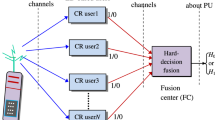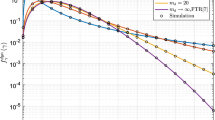Abstract
Diversity reception schemes are well-known to have the ability to mitigate the adverse effects of multipath wireless channels. This paper analyzes the performance of an energy detector with generalized selection combining (GSC) over a Rayleigh fading channel and compares the results with those of the conventional diversity combining schemes such as, maximal-ratio combining (MRC) and the selection combining (SC). Novel closed-form expressions have been derived for the average detection probability over the independently, identically distributed (i.i.d) diversity paths. Receiver operating characteristics (ROCs) and average detection probability versus SNR curves have been presented for different scenarios of interest.
Access this chapter
Tax calculation will be finalised at checkout
Purchases are for personal use only
Similar content being viewed by others
References
Adebola, E., Annamalai, A.: Unified analysis of energy detectors with diversity reception in generalised fading channels. IET Commun. 8(17), 3095–3104 (2014)
Alouini, M.S., Simon, M.K.: An mgf-based performance analysis of generalized selection combining over rayleigh fading channels. IEEE Trans. Commun. 48(3), 401–415 (2000)
Atapattu, S., Tellambura, C., Jiang, H.: Performance of an energy detector over channels with both multipath fading and shadowing. IEEE Trans. Wirel. Commun. 9(12), 3662–3670 (2010)
Cui, G., Kong, L., Yang, X., Ran, D.: Two useful integrals involving generalised marcum q-function. Electron. Lett. 48(16), 1017–1018 (2012)
Hamdi, K., Zeng, X.N., Ghrayeb, A., Letaief, K.: Impact of noise power uncertainty on cooperative spectrum sensing in cognitive radio systems. In: 2010 IEEE Global Telecommunications Conference (GLOBECOM 2010), pp. 1–5, December 2010
Lu, C., Lans, W.: Approximate ber performance of generalized selection combining in nakagami-m fading. IEEE Commun. Lett. 5(6), 254–256 (2001)
Ma, Y., Chai, C.C.: Unified error probability analysis for generalized selection combining in nakagami fading channels. IEEE J. Sel. Areas Commun. 18(11), 2198–2210 (2000)
Nuttall, A.H.: Some Integrals Involving the \(Q_{M}\)-Functions. Naval Underwater Systems Center, New London (1974)
Theofilakos, P., Kanatas, A., Efthymoglou, G.: Performance of generalized selection combining receivers in k fading channels. IEEE Commun. Lett. 12(11), 816–818 (2008)
Yucek, T., Arslan, H.: A survey of spectrum sensing algorithms for cognitive radio applications. Commun. Surv. Tutorials 11(1), 116–130 (2009). IEEE
Acknowledgments
The work has been carried out under the project, “Mobile Broadband Service Support over Cognitive Radio Networks,” sponsored by Information Technology Research Academy (ITRA), Department of Electronics and Information Technology (DeitY), Govt. of India.
Author information
Authors and Affiliations
Corresponding author
Editor information
Editors and Affiliations
Appendices
A Appendix
1.1 Evaluation of \(A_{1}\) in (10)
Using [8, (5)], \(A_{1}\) can be written as:
where, \(I_{n}(\cdot )\) is the modified Bessel function of order n. Using transformation and change of variable, (16) can be written as:
From [8, (29)], the above equation becomes equal to (13) where, \(G_{1}\) can be defined as [8, (25)]:
where,
and \(L_{k}(\cdot )\) is the Laguerre polynomial of degree k.
B Appendix
1.1 Evaluation of \(A_{2}\) in (11)
From (11), \(A_{2}\) can be given as:
From [8, (29)], the above equation becomes equal to (14) where, \(D_{1}\) can be defined as [8, (25)]:
In the above equation, it is important to note that the value of Laguerre polynomial for order 0 becomes 1.
C Appendix
1.1 Evaluation of \(A_{3}\) in (12)
Following the same analogy as in Appendix A, (12) can be written as:
From [8, (29)], the above equation becomes equal to (15) where, \(J_{1}\) can be defined as [8, (25)]:
where,
Rights and permissions
Copyright information
© 2016 ICST Institute for Computer Sciences, Social Informatics and Telecommunications Engineering
About this paper
Cite this paper
Kandpal, D.C., Kumar, V., Gangopadhyay, R., Debnath, S. (2016). Performance of an Energy Detector with Generalized Selection Combining for Spectrum Sensing. In: Noguet, D., Moessner, K., Palicot, J. (eds) Cognitive Radio Oriented Wireless Networks. CrownCom 2016. Lecture Notes of the Institute for Computer Sciences, Social Informatics and Telecommunications Engineering, vol 172. Springer, Cham. https://doi.org/10.1007/978-3-319-40352-6_31
Download citation
DOI: https://doi.org/10.1007/978-3-319-40352-6_31
Published:
Publisher Name: Springer, Cham
Print ISBN: 978-3-319-40351-9
Online ISBN: 978-3-319-40352-6
eBook Packages: Computer ScienceComputer Science (R0)




